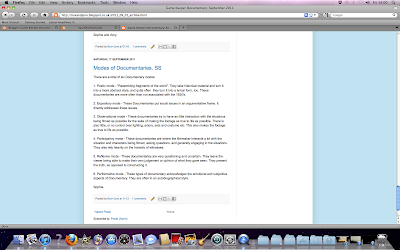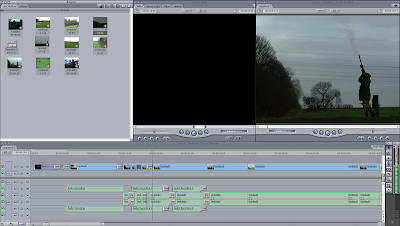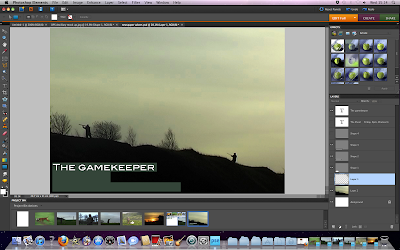 - We used the internet search engines to obtain similar product research. This gave us ideas of some things to use in our product, too. For example, panning shots and title slides. Further internet research gave us more in-depth knowledge on documentaries. For example, the six modes of documentary.
- We used the internet search engines to obtain similar product research. This gave us ideas of some things to use in our product, too. For example, panning shots and title slides. Further internet research gave us more in-depth knowledge on documentaries. For example, the six modes of documentary.- After this, we collected ideas of what we would like to do with our documentary. We came up with three things we definitely wanted for the 5 minute clip. These were to use 'rel people', have a narrating voice over, and to keep to the simplistic style. For example, not using actors, staged events or enhancing editing techniques in the footage. We felt that including these guide lines, we were going to have the ability of creating a more realistic documentary.
- The main idea was to have the documentary about Game Keeping. The reason for this was because both Amy and myself come from very rural backgrounds. She is a Game keeper's granddaughter, and i am a Farmer's daughter. We decided to go to Game keeping after realizing how little coverage the profession had. We found that there were many Farming documentaries, but virtually none on Game keeping. This is what fueled the desire for a fly on the wall coverage documentary on the institution. We also decided that we would preffer to film on a Shooting day, because there is a bad press for the bloodsport of game shooting and felt that we aught to outline that if it was not for people shooting animals, they would have to be culled in the near future, despite the 'wrong morals'.
- After having the decision of the Institutional Documentary genre, both Amy and I went to work searching through YouTube and other internet sites, looking for other Institutional documentaries to use for similar product research. We found many, but a few stuck in our minds because of different aspects. For example, "Ice Road Truckers" and "Airport" both set the standard, and gave us ideas of our filming techniques which included using hand held camera, along with using cuts and fades to show the passage of time as well as creating the needed 'flow'.
- With the information and the similar product research, we were able to gain an a target audience. We made a set of questionnaires and took them home, giving them out to friends and family. along with a few co-workers of Amy's. The questionnaire had queries into a number if subjects, ranging from age and gender, to gender of presenters and what channels people normally watch documentaries on.
- We used NeoOffice to type out the survey, and asked both male and female participants to answer the survey so we could have a comparison between results.
- The next steps from this was to create an updated list of the equipment, and to post the changes to the interview type and to post the change to the channel which would air the show if it was ever made into a full-length program. These changes were due to the survey results being taken into consideration.
- We decided to draw up two sets of storyboards. The reason behind this is the possibility that a Shooting day would not arise. With Jim (The Game Keeper) having a hectic and unpredictable schedule, along with our collage timetables, there was a possibility that we wouldn't all be able to get together on a shooting day to film. In the end, however, we were able to get the shooting day arranged. With all this set out properly, we looked further into other documentaries, to make sure we weren't going to miss anything out in terms of technique. After using Google to search for any Game keeping documentaries, we found one named "The Shoot - The Keeper". This was perfect for us to take ideas from because it is on the same job as ours.
B. Construction.
When it came to the filming day, we ended up using two cameras and tripods, each had a spare battery, too. We thought it would be a good idea to have two cameras because one would be used for the hand held pars of the footage, whereas the other would be used with a tripod, to get the more steady shots. The cameras we used were Panasonic NV-GS75EB (A small, hand held video camera).
Editing of the footage.
 For the editing of the documentary, we used Final Cut Express. Amy stated, "It was hard at first, but once I got a idea of what to do, and how to work things, it got pretty easy". In addition, she also states, "The only other problem I had was when I was trying to relocating the interview to scatter it throughout the footage. The reason for this is was that I didn't understand, at first, how to synchronize the sound and the visuals without interrupting the background noise." This was resolved by finally learning to lock the sound and visuals so they don't affect each other in a negative way. After sorting out this problem, at some points of the footage, the sound had been altered. The reason for this, being that the sound was incomparable with the footage. Amy had to render the sound with 'cmd+R' command on the keyboard. This soon fixed the issue. From there on there was no more trouble with the editing process.
For the editing of the documentary, we used Final Cut Express. Amy stated, "It was hard at first, but once I got a idea of what to do, and how to work things, it got pretty easy". In addition, she also states, "The only other problem I had was when I was trying to relocating the interview to scatter it throughout the footage. The reason for this is was that I didn't understand, at first, how to synchronize the sound and the visuals without interrupting the background noise." This was resolved by finally learning to lock the sound and visuals so they don't affect each other in a negative way. After sorting out this problem, at some points of the footage, the sound had been altered. The reason for this, being that the sound was incomparable with the footage. Amy had to render the sound with 'cmd+R' command on the keyboard. This soon fixed the issue. From there on there was no more trouble with the editing process. When the time came for burning the end result onto a disc, we encountered further troubles. These were that the file was now too big. This meant Amy had to turn it into an Iphone file. After this was done, we then uploaded the footage onto our Blog.
When the time came for burning the end result onto a disc, we encountered further troubles. These were that the file was now too big. This meant Amy had to turn it into an Iphone file. After this was done, we then uploaded the footage onto our Blog.Photoshop.
 - I used Adobe for both ancillary tasks (The newspaper advert and the Double Page Spread). I found an ease of access when using this program. I am fairly familiar with it, from the work I did in the AS course, so I didn't have to get to grips with how it works.
- I used Adobe for both ancillary tasks (The newspaper advert and the Double Page Spread). I found an ease of access when using this program. I am fairly familiar with it, from the work I did in the AS course, so I didn't have to get to grips with how it works.C. Evaluation
As there were only two people in this group, Amy and I decided to do two questions each, with help from each other, too. This was an effective way of dealing with things because it meant the process was quicker, and easier if one of us tackled two questions each. We both used the Blog entries as a reference when completing the evaluation. This was a good way of double checking our remembered facts. Each section of this evaluation is to be posted individually. The reason for this is the use of two Mac computers to hold our work. This method of posting also makes sure the order will be chronological.



No comments:
Post a Comment